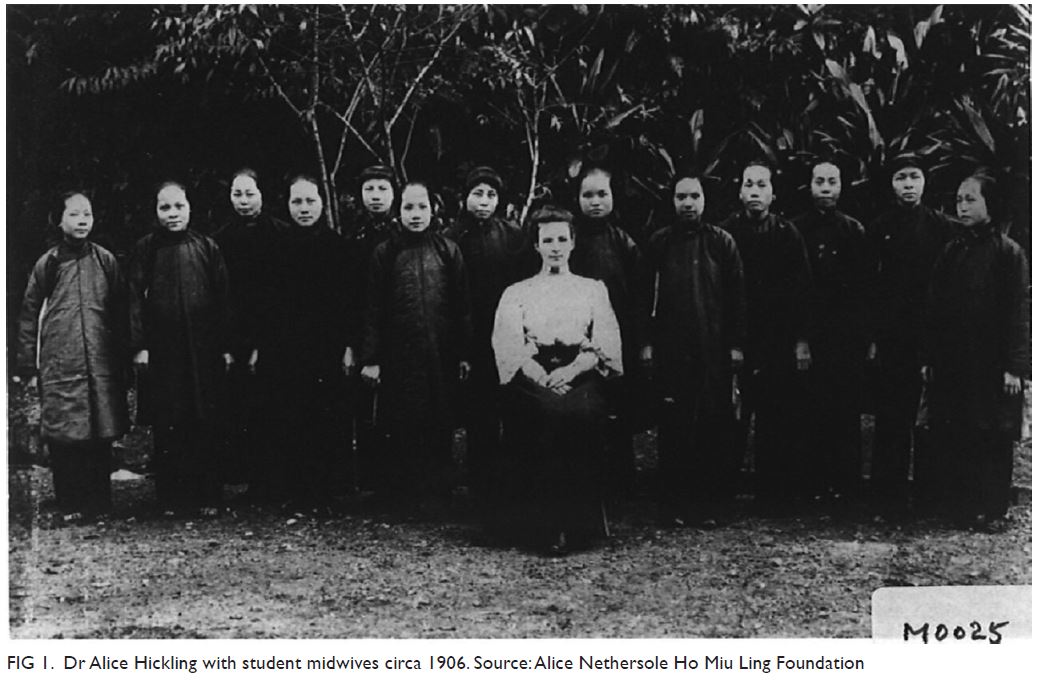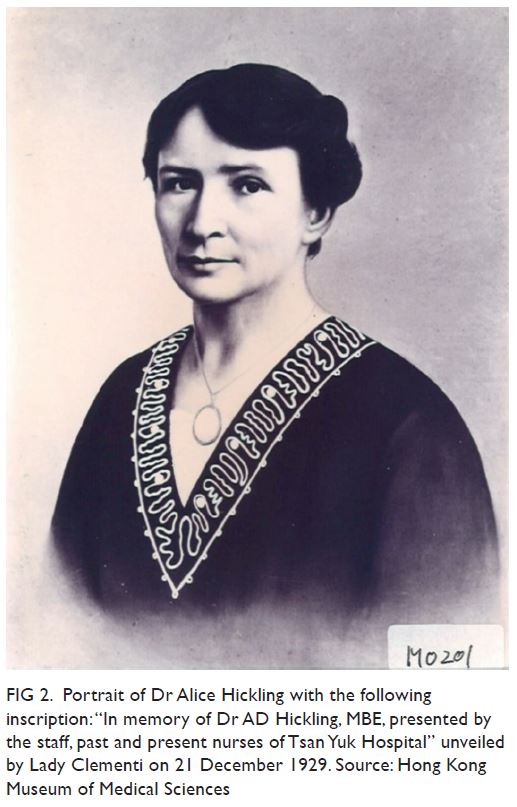© Hong Kong Academy of Medicine. CC BY-NC-ND 4.0
REMINISCENCE: ARTEFACTS FROM THE HONG KONG MUSEUM OF MEDICAL SCIENCES
Dr Alice Hickling (1876-1928): the doctor
who changed the paradigm of maternal care in Hong Kong
Moira Chan-Yeung, FRCP, FRCPC
Member of the Education and Research Committee, Hong Kong Museum of Medical Sciences Society
Dr Alice Hickling was a pioneer in maternal and
infant health in Hong Kong. Born Alice Sibree, she
was a daughter of the Reverend Dr James Sibree, a
missionary and architect of the London Missionary
Society (LMS) in Madagascar. She studied at the
London School of Medicine for Women, received
special training in obstetrics and gynaecology at the
Rotunda Lying-in Hospital, Dublin, Ireland, and was
a licentiate of the Royal College of Physicians and
the Royal College of Surgeons, Edinburgh.1 She was
engaged by the LMS to direct the new Alice Memorial
Maternity Hospital (AMMH) in Hong Kong, which
was built using donations from the Chinese elite in
the community and was completed in 1904.
In the nineteenth century, both infant and
maternal mortality rates were very high in Hong
Kong. Although statistics were not routinely
recorded for maternal mortality or numbers of
live births, estimated infant mortality rates were
unbelievably high—from 700 to over 900 per 1000
births between 1895 to 1906.2 This high infant
mortality led to the appointment of a committee in
1903 to investigate the causes of infant deaths. On
the basis of findings that 50% of all infant deaths
were due to trismus as a result of tetanus infection
and the remainder due to other types of infection
and malnutrition, the committee recommended
more systematic registration of birth and deaths,
free maternity service to attend to confinement
of women in their own homes, training Chinese
midwives, and basic hygiene education for mothers.
The Colonial Administrator, Mr FH May, suggested
training Chinese midwives in the new AMMH.3
There were, however, problems with Mr. May’s
plan. When Western medicine was introduced in
Hong Kong, it was not accepted by the local Chinese
who trusted traditional Chinese medicine. Chinese
women had their confinement at home carried
out by traditional midwives (wan po), who learned
midwifery and delivery skills from oral tradition and
from attending childbirths with another wan po, and
who knew nothing about sepsis, one of the major
causes of maternal deaths.4 At that time Chinese
women would not see a Chinese male doctor let
alone a foreign male doctor. When the LMS asked Dr Ho Kai, who was responsible for raising funds to
build the new hospital, for more donations for the
salary of a doctor for the hospital, Dr Ho Kai and his
friends insisted on having a female doctor to care for
the Chinese women. However, Dr RM Gibson, the
Medical Superintendent of Alice Memorial Hospital,
the first of the Alice affiliated hospitals sponsored
by the LMS, insisted that women should be nurses
and not doctors, an opinion that was unfortunately
prevalent at the time.5 Another hurdle was the
stipulation that this female doctor appointed should
learn Cantonese during the first year after arrival, to
be able to communicate with the locals.
It was under these circumstances that Dr
Hickling entered the scene to become the first
female doctor in Hong Kong. Dr Hickling became
proficient in Cantonese within the first year, and as a
result, she was welcomed into the homes of Chinese
families to do her medical and missionary work. She
recommended that midwives receive formal training
in the Western style, following a 2-year course based
on the British curriculum. Student midwives had
to complete the general nursing training before
being admitted to this programme. The first three
student midwives she trained all passed the first
government examination for midwives held in 1906
and the government sent more midwives to AMMH
for training2 (Fig 1). By 1907, six trained midwives
were employed by the Chinese Public Dispensaries
and government clinics, and they attended to
579 domiciliary confinements that year.6 However,
Dr Hickling was not given any opportunities by Dr
Gibson to attend to general medical patients in the
Alice Memorial Hospital and out-patient clinics.
Instead, at the recommendation of Dr Ho Kai, she
took over maternity work at Tung Wah Hospital and
became the medical officer of Po Leung Kuk (the
Society for the Protection of Women and Children).
She also initiated a health education programme for
mothers after delivery on nutrition and general care
of infants in the hospitals.

Figure 1. Dr Alice Hickling with student midwives circa 1906. Source: Alice Nethersole Ho Miu Ling Foundation
Despite these challenges, by the end of her
contract in 1909, Dr Hickling’s services were much
sought after by Chinese women in the community.
The Chinese elite had been won over and they demanded the next female doctor should be on the
regular staff of the Alice hospitals and should take
charge of Chinese female patients under Western
treatment at Tung Wah Hospital.7
Dr Hickling returned to London at the end
of her contract and resigned from the LMS. On
returning to Hong Kong, she started her own
practice and served the Hong Kong community in
the secular setting. She continued to be responsible
for midwife training at AMMH, and in 1914, she
was appointed to the Midwives Board. She married
Mr CC Hickling, manager of Taikoo Sugar Refinery
in 1915. Dr Hickling became the first female doctor
to be appointed Acting Medical Officer of Health, in
1918, and Assistant Medical Officer in charge of all
Chinese hospitals and Chinese Public Dispensaries,
in 1922.8
When the Eastern District Plague Hospital was
converted into a maternity hospital in 1919, Dr Seen-wan
Ts’o and members of the Eastern District Public
Dispensary invited Dr Hickling to supervise the
hospital.9 The hospital grew quickly, handling close to
200 patients during its first year. When construction
was completed in 1922, Dr Hickling became director
of Tsan Yuk Hospital. At her suggestion, a midwife
training programme was established at the hospital
and the matron of the hospital was sent to attend a
course at Rotunda Hospital. From then, the teaching
of midwifery in Tsan Yuk Hospital was based on the principles of Rotunda Hospital. Dr Hickling also
established gynaecology clinics, a gynaecology ward,
and an operation theatre in Tsan Yuk Hospital. It
was thanks to these efforts that Professor Richard
Edwin Tottenham of the Department of Obstetrics
and Gynaecology at The University of Hong Kong,
gradually transferred the Department’s clinical,
teaching, and research activities to Tsan Yuk
Hospital. As a result, the hospital became not only
the training centre for midwives but also for medical
students and trainees in obstetrics and gynaecology.
Its low maternal mortality set a benchmark for other
maternity hospitals in Hong Kong.
Dr Hickling not only pioneered women’s
medical practice in Hong Kong, she also founded the
first “baby clinic”, precursor to the present Maternal
and Child Health Centres, to care for children aged
up to 2 years at Tsan Yuk Hospital. Other infant care centres were established, first at AMMH and Tung
Wah Hospital,7 then at outside hospitals in different
districts. These centres drew large numbers of
patients each year where babies were weighed and
examined and mothers given instruction in feeding
and care of babies and health education.
Dr Hickling was honoured with the Order of
the British Empire for her services during the First
World War, and received the decoration of Sister of
the Order of St John of Jerusalem. She died in Hong
Kong in September 1928.10 In commemoration of her
25 years of contributions to education and medical
and healthcare to women and infants, a portrait was
presented to Tsan Yuk Hospital by staff and past and
present nurses, to be hung in the Nurses’ Dining
Room. The portrait was unveiled by Lady Clementi
in the presence of Dr Seen-wan Ts’o and many
dignitaries of Hong Kong in December 1929 (Fig 2).

Figure 2. Portrait of Dr Alice Hickling with the following inscription: “In memory of Dr AD Hickling, MBE, presented by the staff, past and present nurses of Tsan Yuk Hospital” unveiled by Lady Clementi on 21 December 1929. Source: Hong Kong Museum of Medical Sciences
References
1. USC Digital Library. International Mission Photography Archive. Available from: http://digitallibrary.usc.edu/cdm/ref/collection/p15799coll123/id/48025. Accessed 20 Jun 2021.
2. Chow AW. Metamorphosis of Hong Kong midwifery. HKJGOM 2000;1:72-80. Crossref
3. May to Lyttelton, 21 July 1904, CO 129/323 #291, 240-3.
4. Medical Officer of Health. Report to the Sanitary Board, Hong Kong Sessional Papers. 1896 to 1907.
5. Editorial. The Lancet 1878;112:226-7.
6. Report of the Principal Chief Medical Officer and Medical Officer of Health for 1907. Hong Kong Sessional Papers, 1908, 409-10.
7. Minutes of Hong Kong District Committee Annual Meeting, 2 March 1909. London Missionary Society, Box 18, 1909, no 311.
8. The Late Dr Mrs Hickling. South China Morning Post 1929 Dec 1.
9. Chan-Yeung M. Eastern District (Wan Chai) Dispensary and Plague Hospital. Hong Kong Med J 2019;25:503-5. Crossref
10. Obituary: Dr Alice Deborah Hickling. Br Med J 1928;2:635-6. Crossref

